We understand the varieties of eggplant: what are their differences
Fast and persistent King of the North, cold-resistant Black handsome, big Sailor and solid Sophia. These are not heroes of TV series, but varieties of eggplants - each with its own character, preferences and advantages.
We have collected a detailed description of eggplant varieties with photos, as well as the secrets of choosing them correctly.
The content of the article
What is the principle for choosing eggplant seeds
The choice of variety depends on the growing region. For warm regions with a temperate climate and fertile soil, late-ripening and mid-ripening varieties are suitable, for cold areas - early-ripening ones. If a eggplant grown in open ground, they recommend frost-resistant and unpretentious hybrids to care for - they have immunity to external climatic changes. For growing in the greenhouse, varieties are chosen that are resistant to high humidity and heat.
Important! When buying, pay attention to the manufacturer of the seeds, expiration date, photographs of the crop and the integrity of the packaging. Learn planting and grooming guidelines.
Early varieties and hybrids
Early varieties and hybrids of eggplant are suitable for growing in the Urals and Siberia. They are not demanding on the composition of the soil and care.
King of the North f1
Early ripening hybrid ripens in 90-100 days. The fruits are tied together, the fruiting period is extended. The king of the north is immune to the main diseases of the culture - powdery mildew and late blight. The fruits are glossy, with a dense purple rind. Length - 30 cm, weight - 150-200 g. White pulp, pleasant to the taste.
Bibo f1
Ripens in 95-105 days. The plant is compact, with powerful shoots and a developed root system. The leaves are green, wavy. Fruits are oval-round, light beige in color. Weight varies from 180 to 200 g, length - 22 cm, diameter - 8 cm. The dense skin protects the eggplant from quick spoilage. The pulp is snow-white, the taste is pleasant. Bibo suitable for growing on an industrial scale.
Black handsome
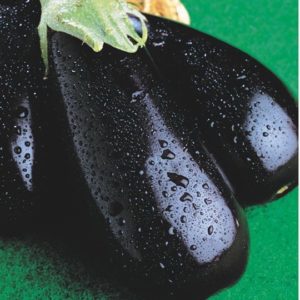
The ripening period is about 90 days. The variety shows a stable yield and bears fruit even in cold weather. It is planted in spacious beds. Fruits are elliptical, dark purple, glossy. Length - 15 cm, weight - about 300 g. From 1 sq. m harvest up to 12 kg. In application Black handsome universal - eggplants are used for canning and pickles, stew, fried and stuffed.
Behemoth f1
Ripening period - 105-115 days. Eggplant Behemoth is unpretentious in care. It is planted both in open ground and in greenhouses. The weight of the fruit is about 100 g, the length is 18 cm. The hybrid is universal in use, it has a tasty pulp. Vegetables make nutritious and juicy snacks, fermented and pickled dishes. A hybrid Hippo is grown for personal consumption and sale.
Galina f1
The fruit has a light and tender pulp, suitable for canning. Reviews of Galina f1 eggplant indicate that it shows a stable yield, gives tasty and juicy fruits. From 1 sq. m harvest 4-5 kg of crop. Eggplant weight - about 120 g, purple color.
Mid-season varieties and hybrids
Varieties with medium ripening periods are grown in central Russia. To obtain a rich harvest, they need fertile and loose soil.
Albatross
Plant height - 80 cm, medium-sized leaves. Ripening period - 130 days. Fruit weight varies from 150 to 200 g, length - 18 cm, diameter - 5 cm. Color dark purple, large stalk. The pulp is light beige, the taste is neutral. From 1 sq. m harvest about 7 kg.
Diamond
The ripening period is 128 days from the moment of seed germination. To obtain a rich harvest, they are planted in seedlings. The length of the fruit varies from 15 to 17 cm, the average weight is 220 g. The flesh is pleasant, light, the rind is purple. Variety Diamond appreciated for the long storage periods and transportability, grown for sale. The yield varies from 4 to 6 per sq. m.
Marzipan
The plant reaches a height of 65-70 cm, the bushes are compact. Eggplant weight - 300 g, length - 18 cm. The shape of the fruit is pear-shaped, the peel is black-purple of medium thickness, the flesh is white with a sweetish taste. From 1 sq. m harvest from 3 to 5 kg. Marzipan is suitable for growing in small areas.
Sailor
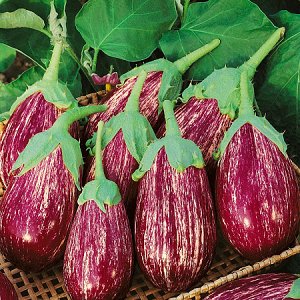
Ripening period - 125-140 days. The name Matrosik eggplant was due to its striped color. The pear-shaped fruits of a light purple hue have white veins, the eggplants look delicious and original. Weight - up to 250 g, length - 15 cm. Pearl-colored pulp, sweet. From 1 sq. m. gardeners collect about 5 kg of beautiful and tasty fruits.
Roma f1
Tall plants reach a height of 2 m, they are grown in greenhouses and open ground. Ripening period - 130 days. Length - 23 cm, weight - up to 300 g. The rind is dark purple, dense. The shape is pear-shaped, the flesh is dense and fleshy, without bitterness. From 1 sq. m collect about 5 kg. A hybrid is used immediately after harvest - vegetables are not suitable for long-term storage.
Late-ripening varieties and hybrids
Such eggplants are planted through seedlings - this allows you to strengthen the plant's immunity, enhance their protection against diseases and pests.
Sophia
The ripening period is 140 days. A tall plant reaches a height of 1.5 m. Fruits are large, pear-shaped, weight of one - 700-800 g. The pulp is light, without bitterness. The rind is thick, so the fruit does not crack, and the crop is suitable for long-distance transportation. From 1 sq. m harvest from 5 to 7 kg of juicy eggplant.
Mishutka
Plants are miniature, reach a height of 80 cm. Ripening period - 145 days. The shape of the fruit is round-pear-shaped, weight - up to 300 g, length - 16 cm, diameter - 8 cm. The peel is black, glossy. Productivity - 5 kg per 1 sq. m. Variety Mishutka is universal in application, vegetables are used for cooking summer snacks and salads. Eggplants are harmoniously combined with garlic, tomatoes and herbs.
Bull forehead
The ripening period is 150 days. The variety is unpretentious in cultivation, suitable for planting in any region. Eggplant length - 20 cm, weight - up to 1 kg. The peel is glossy, brownish-purple. The pulp is dense, light beige, not bitter. The crop is suitable for processing and long-term storage. Eggplant varieties Bull forehead are high in phosphorus, calcium and iron.
The best varieties and hybrids for open ground
Outdoor cultivars and hybrids are immune to insect pests and diseases. Productivity does not depend on rain, wind and other climatic conditions.
Alekseevsky
The advantage of the variety is resistance to frost and cold. Branched bushes grow up to 75 cm. Fruit ripening period is 120 days. Eggplant weight - 150 g, cylindrical shape, tender pulp. Productivity - 9 kg per 1 sq. m. The variety is universal in application.
Vakula
Suitable for growing in gardens and fields. The plant is 1.5 m high, the fruit ripening period is 95-105 days. The pulp is firm, sweetish. The rind is thick, dark purple in color. The weight of one fruit is 400 g, from 1 sq. m collect up to 12 kg. Vakula can be stored for up to three weeks in basements and cellars.
Joker
Up to 10 fruits are formed on one plant, so the bushes need a garter. Plant height - 1.4 m, ripening period - 90 days. The shape of the fruit is rounded-elongated, the color is lilac. Length - 19 cm, diameter - 7 cm.The pulp is light, without bitter taste. Productivity - 8 kg per 1 sq. m.
Bourgeois f1
Ripening period - 110 days. Hybrid it has a stable harvest and amicable fruiting. Plant height - 1.5 m. Rounded fruits of rich purple color, fruit weight - up to 1 kg, diameter - 14 cm. The hybrid is resistant to late blight and powdery mildew. To get a rich harvest, gardeners regularly fertilize beds with liquid manure.
Negus
Resistant to weather changes. Plant height - 50-60 cm, suitable for landing in small areas. The shape of the fruit is round, the skin is purple, glossy. Weight varies from 200 to 300 g. The pulp is tender, not bitter. Productivity - 5 kg per 1 sq. m. The Negus variety is appreciated for its taste; delicious caviar.
Chinese lantern
Eggplants of the original red color decorate the vegetable garden. The height of the bush is 70 cm, the flowers are large, white. Ripening period - 115 days. The shape of the fruit is round, red or bright orange. The pulp is yellow-white, tasty and pleasant. Weight - 170 g, yield - 3 kg per plant. The harvest looks spectacular as a decoration for a festive table.
Emerald f1
In cultivation, the hybrid is unpretentious and frost-resistant, resistant to diseases. Plant height - 1 m, sprawling shoots. Ripening period - 110 days from the moment the first shoots appear. The fruits are elongated, green in color. Vegetable mass - up to 450 g. The pulp is not bitter, beige. Productivity - 5 kg per 1 sq. m.
Drakosha
The variety is popular in the Urals and Siberia; it can grow in weak soils. Plant height - 1 m, average foliage. The ripening period varies from 105 to 125 days. The fruits are pear-shaped and round, the skin is smooth and glossy, purple. Eggplant weight - 300 g, length - 20 cm. Productivity - 5 kg per 1 sq. m.
Multicolored varieties
Multicolored eggplants will decorate any garden - the original fruits of unusual colors delight the eye. Gardeners distinguish:
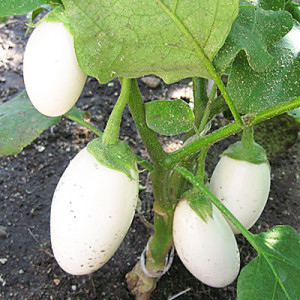
- White egg... Vegetables are similar to white testicles - they have a smooth white skin that resembles an eggshell. Fruit weight - 200 g, length - 10 cm.Pulp to taste resembles mushrooms.
- Kermit. Small fruits of green color with white veins. Fruit weight varies from 80 to 150 g. The harvest is consumed raw and boiled.
- Mantle. Eggplants have a yellow-orange skin with green stripes. The mass of the vegetable is about 120 g. The taste is without bitterness, the variety is universal in application.
Round varieties
Round eggplants in cultivation and leaving do not differ from oval and cylindrical. Outwardly, they resemble large apples. Common varieties:
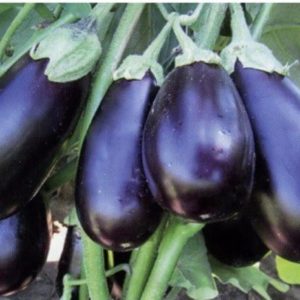
- Helios. The variety is grown in greenhouses and open field. The color is dark purple, the weight of the fruit is about 120 g. Productivity is 5 kg per sq. m.
- Globe. Early ripe eggplants weigh 80-100 g. The rind is purple with white stripes. The pulp is tasty, without bitterness.
- Leader. Fruits are dark, black-purple, thick rind. The harvest is stored for a long time. From 1 sq. m collect about 6 kg.
Tall eggplant
Tall bushes are grown in greenhouses. A month after planting, they are tied to a support so that the shoots do not break under the weight of the fruit... The most famous are:
- Baikal f1. Plant height reaches 1.4 m.The hybrid is resistant to humidity and abrupt weather changes. The pear-shaped fruits are purple in color. The weight of the eggplant is 89 g, the pulp is juicy and tasty.
- City f1. Plant height reaches 3 m. Fruits are cylindrical, large. The weight of one is about 200 g. The harvest city is used for the preparation of winter preparations.
- Fabina f1. Plant height - 1.3 m, average foliage. The fruits are purple with a bright glossy sheen. Suitable for long distance transportation.
Undersized
Low-growing eggplants take up little space, so they are convenient for growing in compact garden plots. Don't need a garter. Common:
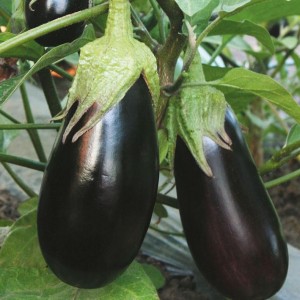
- Bagheera f1. Bushes are compact, they reach 80 cm in height. Fruits are firm, weight - 60-100 g. The taste is rich, the pulp is light.Eggplants are stored for a long time and do not lose their presentation.
- Bull heart f1... A mid-season hybrid ripens in two months. Plant height - 70 cm. Eggplant weight - about 400 g, the skin is shiny, purple. The taste is deep, there is no characteristic bitterness.
- Robin Hood. The height of the bush is about 90 cm. The color of the fruits is light lilac, weight - 250 g. The variety is resistant to insect pests, unpretentious in care.
No seeds
Seedless eggplants are actively used in cooking. The most delicious and beautiful dishes are made from them. Such fruits are used for baking and stewing, cooking vegetable casseroles and stews:
- Galich. The ripening period is 114 days from the moment the first shoots appear. The fruits are cylindrical and elongated, the weight of one is 185 g. The color is violet, glossy. Tasty and juicy seedless pulp is used to prepare juicy and tender caviar.
- Milada f1. Ripening period - 100 days. A hybrid is grown in central Russia. Vegetables are oval-cylindrical, fruit weight - 120 g. The pulp is dense, with a rich taste.
- Lolita f1. Plant height - 3 m. Suitable for growing in a greenhouse. Eggplant weight - 300 g, length - 20 cm. The pulp is medium density, light green.
Conclusion
The seeds of the best eggplant varieties guarantee high and stable yields. The choice of seeds depends on the growing location and climatic conditions. Early varieties are chosen for regions with short and cold summers, late and middle ones - for the middle lane and the south. Seedless varieties are suitable for preparing various dishes; they have a tender and dense pulp. Eggplant makes nutritious and healthy snacks and salads.